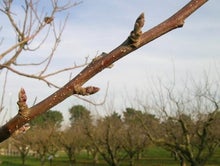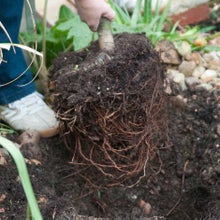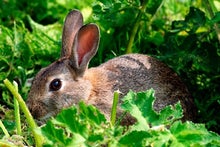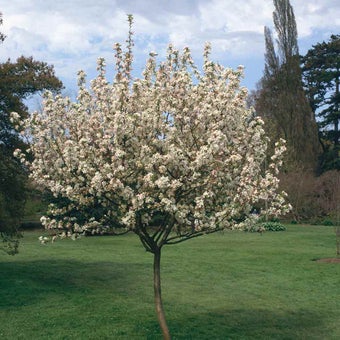
Quick facts
Suitable - for One- and two-year-old apple and pear trees
Timing - November to March
Difficulty - Moderate
Before you start
How you prune your young tree will depend on its age and form, as well as the ultimate size and shape you want to create.
Your young tree
Young apple and pear trees are sold in three main forms – which you have will affect how much formative pruning you’ll need to do:
- Unfeathered maiden – a one-year-old tree without side-shoots, so just a single stem. This stem needs pruning to encourage branching
- Feathered maiden – a one-year-old tree that has side-shoots on the main stem
- Two-year-old tree – usually bought partly pre-trained to form a ‘bush’ tree (see below) with the top of the central stem pruned to encourage branching


See our guide to buying trees and our guide to choosing apple trees.
Aims of initial pruning
This method of initial pruning aims to create a free-standing tree with a short 70–90cm (28–32in) trunk topped with a goblet-shaped crown that has an open centre. Although essentially a short tree, for pruning purposes this form is known as a bush tree. It’s well suited to domestic gardens.
You can use the same pruning method for training half-standard and standard apple and pear trees, which simply have a taller clear trunk than bush trees – 1.2–1.5m (4–5ft) for half-standards and 1.8–2.1m (6–7ft) for standards. Such trees need to be grafted onto vigorous rootstocks such as MM111 or M25.
For advice on pruning space-saving restricted forms of apple and pear trees, see cordons, stepovers and espaliers.
Why prune new trees
Although this initial pruning will remove a large proportion of the growth (that you paid good money for), including potentially fruiting shoots, it’s better for the tree long term. If left unpruned, it will either develop long, lax branches that bend under the weight of their crop or will start fruiting towards the tips of long branches, failing to develop a good shape.
When to prune new apple and pear trees
Initial pruning should be done straight after planting, when the new tree is , between leaf fall and burst (usually November to early March).
The best time to plant new apples and pears is from autumn to early spring, but container-grown trees can also be planted in late spring and summer. In this case, it’s generally better to delay initial pruning until the following winter. The young trees will already be producing leaves and shoots, so pruning at planting time may not stimulate good new growth from the dormant on pruned side-shoots.
How to prune new apple and pear trees
When pruning, always use sharp secateurs and make your cuts just above and sloping away from a .
Pruning an unfeathered maiden
After planting prune this single-stemmed tree (with no side-branches)
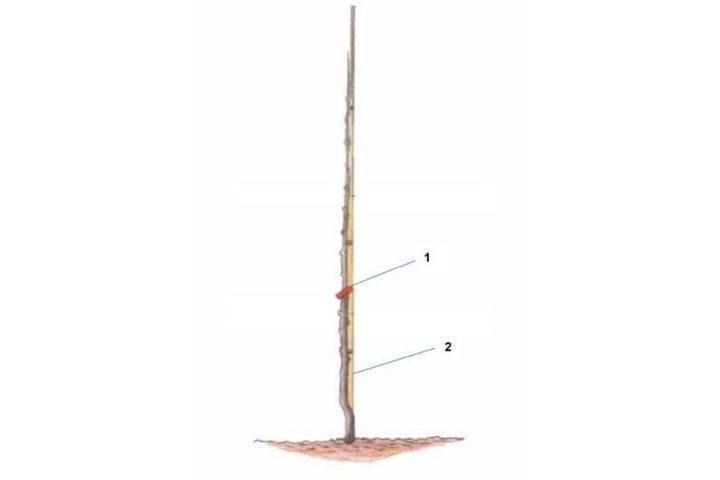
- Cut back the bare stem just above a bud about 75cm (2½ft) from the ground, making sure there are three or four healthy (not dried-up or damaged) below. With trees grafted onto a dwarfing M27 rootstock, prune to 60cm (2ft) tall. This will stimulate branching (growth of new side-shoots)
- Remove the , if you’ve not done so already, and replace with a stake
The next winter, follow the steps for Year 1 pruning, below
Pruning a feathered maiden or a two-year-old tree
Year 1 pruning
A feathered maiden (a one-year-old tree with side-shoots) and a newly bought two-year-old tree should both be pruned in a similar way (with just a slight difference in step 2).

- Select three or four strong, evenly spaced, wide-angled, outward-growing side-shoots (laterals). The topmost should be about 75cm (2½ft) from the ground (60cm/2ft for a tree on a dwarfing M27 rootstock). The chosen side-shoots should radiate from the main stem like the ribs of an upside-down half-open umbrella
- With a feathered maiden, cut back the main stem to just above the selected topmost side-shoot, ensuring there are three or four good strong side-shoots below. With a two-year-old tree, the main stem will usually already have been cut back by the grower, but the tree will probably have sprouted a replacement upright shoot. Cut this back to just above your topmost side-shoot
- Shorten your selected side-shoots by a half to two-thirds, cutting just above an outward-facing bud
- Remove any additional side-shoots below these, to create a clear trunk
Year 2 pruning
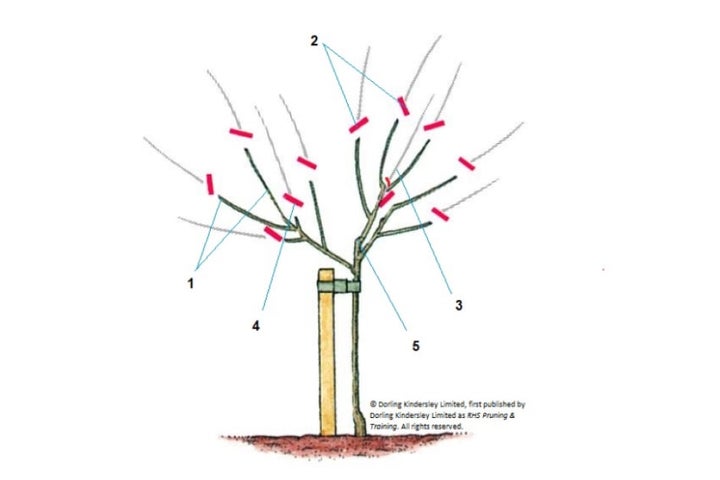
- Select eight to ten of the side-shoots to form the permanent framework of branches, from which the fruiting branches will grow. The selected side-shoots should be well spaced
- Shorten these side-shoots by one-third to a half, pruning just above a healthy outward-facing bud or prune to upward-facing bud if the side shoots is flat or banding downwards
- If too many side-shoots formed close together, thin them out by removing the unwanted shoots entirely
- Remove any shoots not needed for the main branches
- The tree may produce another strong upright shoot in the centre. If this happens, remove it entirely, to keep the centre of the crown open
Year 3 pruning

- On the main branches, cut back the new growth produced last year by a quarter
- Leave the side-shoots arising from the main branches unpruned – they will produce fruiting spurs and carry fruit. Only remove these side-shoots if they’re growing into the centre of the crown, are overcrowded or are rubbing against each other
Year 4 pruning and beyond
From now onwards, follow our guide to winter pruning of established apple and pear trees. If you’re new to pruning or aren’t feeling very confident, check out pruning made easy.
You may find hady our guide to identifying fruit buds
Frequently asked questions
Can I let my new tree produce fruit?
In the first year after planting, young trees need to concentrate on establishment and crown development rather than fruiting. So remove any young fruit that form.
In the second year, if the tree is establishing and growing well, you may let one or two fruit develop.
Problem solving
There are few probles associated with pruning new trees, although they can be prone to poor establishment and rabbit damage.


